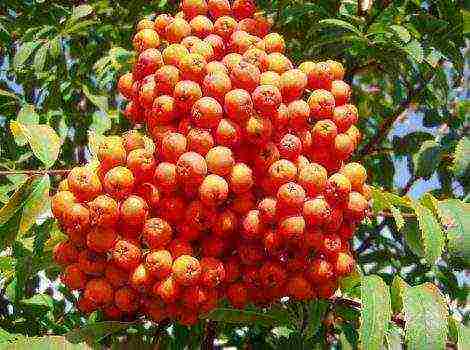Content
- 1 Savoy cabbage: growing and care
- 2 The best varieties of Savoy cabbage
- 3 What is Savoy cabbage
- 4 Varieties included in the State Register
- 5 Planting savoy cabbage
- 6 Growing features
- 7 Cleaning and storage
- 8 Reviews
- 9 Features of savoy cabbage
- 10 Savoy cabbage cultivation
- 11 Savoy cabbage care
- 12 Savoy cabbage harvesting and storage
- 13 Savoy cabbage varieties
- 14 Savoy cabbage diseases
- 15 Disease control methods
- 16 Savoy cabbage pest control
- 17 Question answer
- 18 Savoy cabbage - planting and care
- 19 The best varieties of Savoy cabbage - description
- 20 Savoy cabbage rolls - recipe
What is a Savoy cabbage? Some summer residents and gardeners believe that this is a hybrid variety of white cabbage. This is by no means the case. Savoy is a separate subspecies with its own characteristics and principles of cultivation and care. This vegetable has an extraordinary look, which attracts attention.
Summer residents do not plant it often. This trend is explained by the lack of sufficient information about this type of cabbage, low demand for its fruits. As for leaving, one should dispel judgments about any difficulties, and firmly note that the cultivation of Savoy cabbage is not much more difficult than other types (Peking cabbage, white cabbage, broccoli).
Savoy cabbage is native to Italy. It is named after the County of Savoy, where it was bred by local breeders. In the eastern part of Europe, it appeared at the end of the 18th century, but it never caught on and was not particularly popular until the beginning of the 21st century. Today it is widely grown in North America, Central and Southern Europe.
Savoy cabbage is positioned as a two-year crop. Mainly green and light green shades of leaves and fruits predominate. The density of the heads is not the same as that of the white cabbage. Weight - about 3 kg.
In the second year, Savoy cabbage throws out a long, rather branched stem, on which seed material (inflorescences) is formed. Collecting them will multiply this type of cabbage.
10 kg. from one square meter - the yield of savoy cabbage. Growing and care (see photo) must be appropriate. Along with white cabbage, Savoy is superior in taste, protein saturation and vitamins.
It should be noted that some housewives use savoy cabbage to decorate the festive table.
Among the main advantages of the culture is its frost resistance. Late varieties (Alaska F1, Stilon F1, Kozima F1) are especially distinguished by this indicator. The fruiting period of late varieties is about 130-140 days from the moment of planting in the soil. Seeds germinate already at a temperature of + 30C. To ensure a normal growing season, about 18-20 degrees above zero is enough. The sprouts are able to withstand frosts down to -6 below zero. The same property is characteristic of both early and mid-late varieties. Ripe fruits of late varieties can even withstand sub-zero temperatures up to 120C.
The main cultivation of Savoy cabbage is carried out in the open field.
Savoy cabbage: growing and care
Many summer residents grow Savoy cabbage from seeds, and also use the seedling method. The technology of growing Savoy cabbage seedlings is almost no different from the technology of growing other species.
The first thing to do is to prepare the soil in the fall. To do this, it is necessary to clearly determine the place on the garden plot, which is most suitable for growing a vegetable. The place should be well lit. The best precursors for savoy cabbage are crops such as cucumbers, potatoes, tomatoes, onions, beets, and beans.
When the territory in the garden is determined, it should be dug up to a depth of 20 cm (shovel bayonet). Then organic fertilizers are applied. Summer residents consider a solution of urea or humus to be the best. It should be entered in the calculation of 8-10 liters. per 1 m2. The amount of organic matter is calculated in a 1: 2 ratio.
In the spring, it is recommended to loosen the soil by using the harrowing method. This measure will also saturate the soil with oxygen.
It should be noted that the seedlings need sufficient moisture, so they are watered in moderation in the morning every other day.
The pick is carried out 14 days after planting the seed. In open ground, the sprouts are planted when the first four or five healthy leaves have appeared. The seedlings are fully ready for planting in about 40 days.
Savoy cabbage varieties are transplanted on a cloudless sunny day. The peculiarity of Savoy cabbage is that it ripens more early than white cabbage, so the harvest can be obtained earlier.
Loosening, moistening and hilling are important elements of modern technology for growing savoy cabbage. The denser the soil, the deeper the loosening is carried out, but no more than 5 cm. 21 days after the loosening, it is necessary to carry out the hilling. At the same time, it is necessary to apply mineral complex fertilizers (for 10 liters of water, add 40 g of superphosphate, 15 g of potassium fertilizers and the same amount of urea).
The next feeding is carried out during the formation of the head of cabbage. The dosage is increased by about one and a half times.
Watering adult plants is carried out once a week in the evening. Particularly demanding early varieties for moisture saturation.
After the harvest is harvested, it must be stored at a temperature of 1-3 degrees below zero. The best storage method is to arrange them in boxes so that the heads are not squeezed or crushed.
The best varieties of Savoy cabbage
Early varieties
Mid-season varieties
Late varieties
It is rare to find a plot where cabbage is not grown at all. Most often, gardeners plant white cabbage. However, there are other varieties, for example, its relative - Savoy cabbage, which also belongs to the type of Cabbage.
What is Savoy cabbage
Like the usual white cabbage, Savoy cabbage has large heads of cabbage, but their structure is loose, and the leaves are thin and corrugated.
Although Savoy cabbage is cold-resistant and therefore suitable for the Russian climate, it is not very common in our country. Probably, this is the case because of the low yield, compared to the white one. There is another disadvantage - Savoy cabbage cannot be fermented. However, it tastes better, softer than traditional cabbage and is perfect for salads, stews, soups and pie filling.
The nutritional value
Savoy cabbage is not only tasty, but also healthy:
- Compared to other types of cabbage, it contains more vitamins and minerals, such as phosphorus and calcium;
- a significant amount of potassium has a good effect on the heart and blood vessels;
- vitamin C in it is not less than in citrus;
- rare vitamin U is also found in savoy cabbage;
- there is practically no starch and sucrose in it, which is good for diabetics;
- Savoy cabbage contains a lot of fiber and is therefore suitable for dieters.
Due to its high fiber content, Savoy cabbage is not recommended for people with gastritis, pancreatitis and gastrointestinal ulcers, as well as for those who have recently undergone surgery in the chest or abdomen.
Table: Nutritional value of Savoy cabbage (per 100 grams)
Video: useful properties of savoy cabbage
Varieties included in the State Register
Many growers produce Savoy cabbage planting stock, and there is no single opinion which one is better. General recommendations for selection are as follows:
Consider the most popular varieties of savoy cabbage, registered in the State Register of Breeding Achievements.
Early ripe
Early ripening varieties ripen in 105–120 days. They are suitable for eating fresh or frozen.
- Gold early. High-yielding cabbage with dark green heads weighing 800 grams. Resistant to cracking. Ripens in 90-110 days.

Cabbage variety Zolotaya early has strong corrugated leaves
-
Jubilee 2170. Early ripening cabbage, ripens in 85-110 days. Heads of cabbage are light green, grayish, weighing up to 800 grams. Prone to cracking.
- Petrovna. Heads of cabbage are dark green on the outside, and light yellow inside, the weight of one is slightly more than a kilogram. Ripens in 100-110 days.
- Moscow lacemaker. An early ripening variety with light green blistery leaves with a slight waxy bloom and heads of cabbage weighing about 1 kg. The taste is excellent.
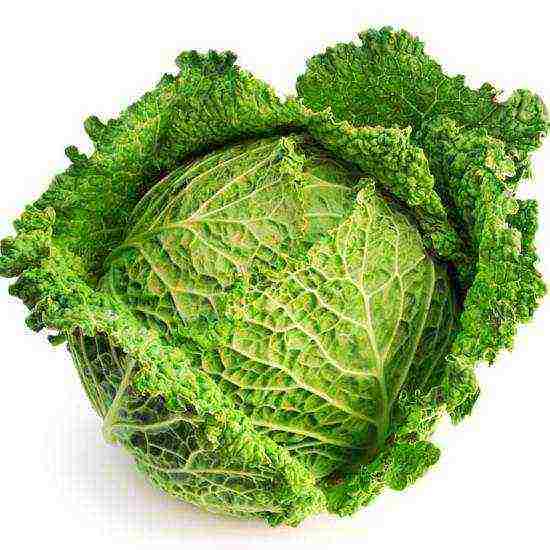
Cabbage variety Moscow lacemaker has a beautiful appearance
Mid-season
Mid-season varieties ripen in 120–135 days. These include:
- Twirl 1340. The heads of cabbage are medium in size, with strongly corrugated leaves, reaching a weight of 2.5 kg. The cabbage tastes good, but it is not suitable for long-term storage.
- Uralochka. Leaves are strongly knotty, slightly wavy, light green, heads of cabbage weighing about 1 kg.
- Melissa. Heads of cabbage are dark green, weigh on average 2-3 kg. This cabbage tastes good and can be stored for 4-5 months in addition.
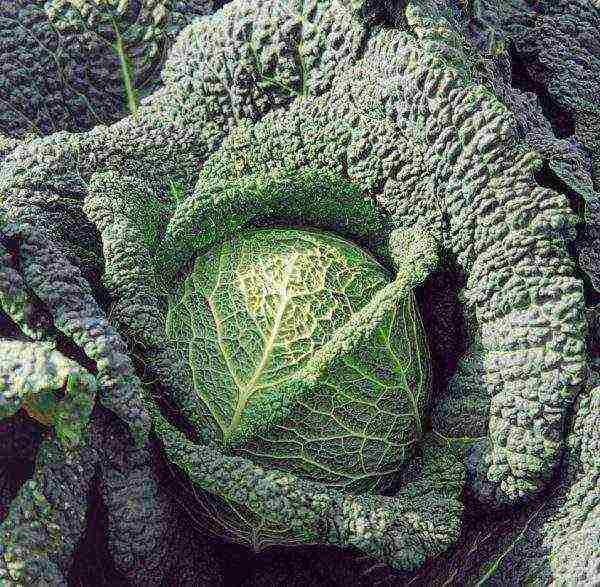
Melissa cabbage is a hybrid, therefore it has an F1 prefix to its name
Late ripening
Late-ripening varieties of Savoy cabbage reach maturity in 140 days or more. They are believed to be best suited for winter storage.
- Nadia. The heads of cabbage are gray-green in color, weighing about 1 kg, the leaves are wrinkled and blistery. Cabbage has a high taste, but not very well stored.
- Viros. Heads of cabbage are medium-sized, weighing 1.8–2.5 kg, blue-green in color, with highly bubbly leaves covered with a waxy coating. Cabbage of this variety is suitable for long storage.
- Alaska. Heads of cabbage are gray-green, weight of one on average is 2.3 kg. The leaves are wavy, with a strong waxy bloom. Cabbage has an excellent taste and is suitable for long-term storage.

Alaska cabbage is suitable for long-term storage
Planting savoy cabbage
Seeds of early varieties are sown for seedlings in the second decade of March, and of middle and late varieties - in the second decade of April..
Sowing seedlings
Sowing is done as follows:
- Prepare the soil by mixing equal proportions of turf, sand and peat. You can also buy ready-made soil.
- It is advisable to disinfect the earth with a solution of potassium permanganate.
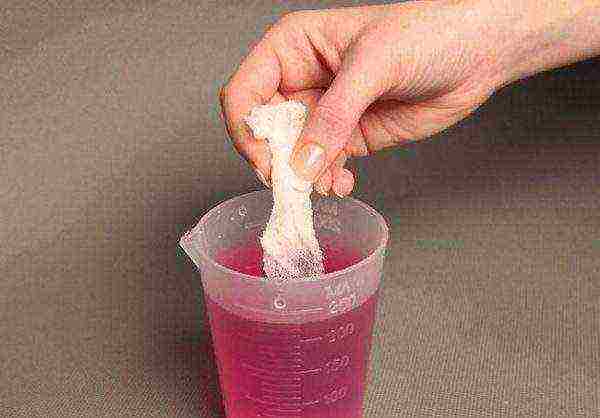
Before planting, it is advisable to subject the seeds to standard processing: calibration, disinfection in a solution of potassium permanganate or in another way, as well as their hardening
- Plant seeds in moist soil 1 cm deep.
- Cover crops with glass (some use polyethylene).
- Provide temperature up to 20 C, preferably 18 C
- On average, seedlings appear in 5-7 days.
- With the emergence of sprouts, the temperature is reduced to 8–10 C days. In the case of a higher t, the plants are too elongated.
- The sprouts are freed from the shelter and placed in a bright place.
- In face 1 of this leaf, the temperature can be increased to 13-14 ºC during the day and 10-12 ºC at night.

You can take pots and 6 cm in diameter
Picking
After the appearance of the first true leaf, the seedlings are planted if they were planted in a common box. Before transplanting, you need to water the seedlings well so that it is easier to get the plants out of the ground. Also, the roots are pinched to 1/3 of the seedlings. After that, you can water the plants with a weak solution of potassium permanganate. Within three days after transplanting, the temperature for seedlings should be 17-18 C, after which it must be lowered to 13-14 C during the day and 10-12 C at night.
Features of seedling care
Watering of seedlings at all stages of development is carried out as the soil dries up. A couple of weeks before planting the plants in a permanent place, you need to start hardening them. To do this, they are taken out onto a glazed loggia or placed on a half-open window. At first, for an hour or two, then the duration of the procedures is increased to a whole day. Drafts should be avoided.
It is advisable to carry out the following dressings:
- When the first pair of true leaves has developed, root feeding of the seedling is carried out with a solution of complex fertilizer (1 teaspoon for 2 liters of water). The liquid should be watered the plant, as with ordinary water, do not overdo it.
- The second, foliar feeding, is carried out during the hardening of the seedlings. To prepare the solution, dissolve in 10 liters of water in a tablespoon of urea and potassium sulfate. Spray the seedlings at the rate of 1 cup of the mixture per plant.
Disembarkation to a permanent place
It is better to choose a place for the beds of Savoy cabbage in the south or southeast, as it loves warmth and bright lighting. Acidic soils are not suitable for it, neutral ones are preferable. The culture grows best on loam and sandy loam, but its cultivation on sandy and clay soils will cause difficulties. The earth is prepared in the fall, digging up the soil and lime it if necessary. In the spring, the site is fertilized with rotten manure or compost (3-4 kg per 1 square meter) and wood ash (100-200 g per 1 square meter). Ash can be replaced with a complex mineral fertilizer (30–40 g per 1 sq. M.). After the spring introduction of nutrients, the earth is also dug up.
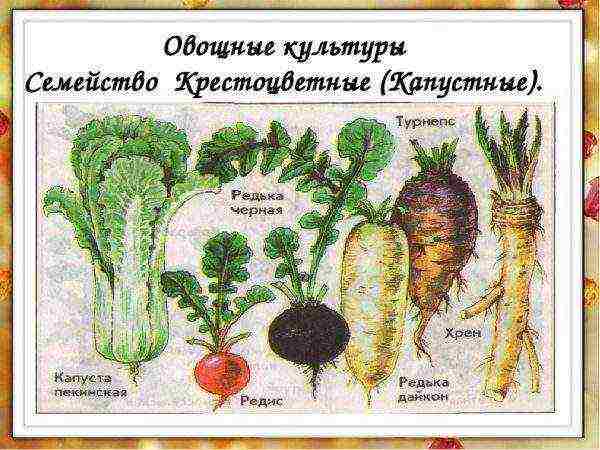
All varieties of cabbage, as well as other plants of the Cabbage family (Cruciferous) are not suitable as predecessors or neighbors for the Savoyard
Seedlings are planted after 2-3 pairs of true leaves appear. The planting scheme depends on the ripening period; for early-ripening varieties 40X40 cm, mid-ripening - 50X50 cm, late-ripening - 60X60 cm.
- 2 hours before planting, the plants are well watered.
- The seedlings are deepened to the first leaf.
- After planting, the plants are also watered.
- The first few days the cabbage is shaded from direct sunlight.
- If there is a threat of frost at night, the plants should be covered with foil.
It is best to plant Savoy cabbage after potatoes, legumes, onions, beets, tomatoes and cucumbers. But after the plants of the Cruciferous family, at least 3 years should pass.
Video: planting savoy cabbage for seedlings
Growing features
Care includes the standard activities for any cabbage:
- Watering. Plants should be watered for the first time after transplanting to a permanent place at intervals of every two to three days at the rate of 8 liters of water per 1 sq. Later, watering is carried out once a week at the rate of 13 liters of water per 1 sq.m. However, this is an approximate schedule, first of all, you need to focus on the weather and soil condition. In rainy weather, watering is carried out less often, in heat more often: the soil should not dry out. Most of all, water is needed in May for early varieties and in July-August for late ones.

The main activities for the care of Savoy cabbage are loosening, watering and weeding
- Loosening. The first time the soil is loosened immediately after planting young plants to a permanent place, to a depth of 5–7 cm. Further, loosening is carried out once a week, to a depth of 12–15 cm; the heavier and wetter the soil, the deeper it should be loosened.
- Hilling. It is produced a month after planting, or a little earlier. Late-ripening varieties are hilled again by closing the rows, approximately one and a half weeks after the first hilling.
- Weeding. Weeds should be removed from the beds as needed.
- Prevention of pests and diseases. As a preventive treatment, if you do not want to use chemistry, the plants are pollinated with wood ash (1 glass per 1 square meter), and watering the earth with a solution of potassium permanganate is effective against fungus. You also need to inspect the leaves, especially from the underside, in order to notice insects and their eggs in time.
For normal growth and development, the plant needs nutrients, therefore, fertilizing is carried out twice a season:
- When the seedlings planted in a permanent place begin to grow, you need to feed it:
- solution of cow dung in water (in a ratio of 1:10)
- or a complex mineral fertilizer (15 g of urea, 15 g of potassium sulfate, 40 g of superphosphate per 10 liters of water).
- The second feeding is done with mineral fertilizer, when the leaves of the cabbage begin to curl. For her, the dosage of superphosphate and potassium is increased by 1.5 times.
Cleaning and storage
Early ripening varieties are harvested when the heads of cabbage become firm. The timing of harvesting late-ripening varieties is chosen depending on whether long-term storage is expected. For winter storage, heads of cabbage must be harvested at a temperature of at least -3 C.
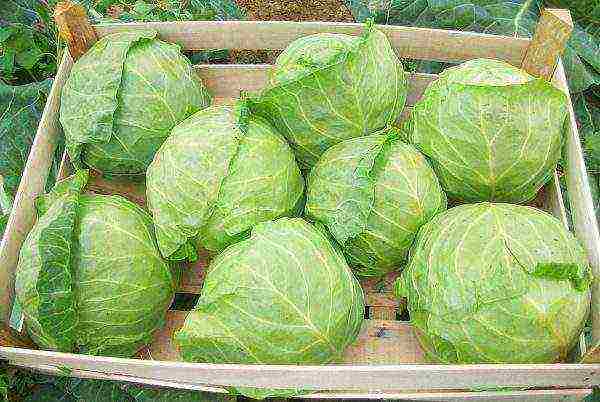
The best way to store cabbage is to put it in wooden boxes, but the heads of cabbage should not touch each other.
It is worth remembering that Savoy cabbage leaves are edible too.
In order for cabbage storage to be successful, you need to follow some rules:
- It is undesirable to water the plant before cutting the heads.
- It is better to cut cabbage in dry weather.
- It is necessary to leave 2-3 sheets of covering leaves on the head of cabbage, which will protect it from external influences.
- Heads of cabbage must weigh at least a pound; the larger the head of cabbage, the better it is stored.
- Only healthy heads of cabbage are suitable for long-term storage:
- which are not frostbitten;
- do not have rotten areas;
- not infested with pests or fungal diseases.
Before you put the cabbage for storage, you need to dry it: sprinkle the heads of cabbage with chalk crumbs and spread them for two or three days in a dry room on shelves, preferably trellised ones. You also need to shorten their stumps to two or three centimeters.
Theoretically, you can store Savoy cabbage for up to six months, but many gardeners talk about two to three months' storage at best. Creation of the right conditions plays an important role:
- The heads of cabbage should be stored in wooden boxes, leaving a distance of several centimeters between them.
- The cabbage is stored in the position of the cut stump upwards.
- Storage temperature from 0 to 3 C.
- Air humidity 90–95%
- The storage room should be free of fungus, mold and rodents; it is advisable to treat the basement or cellar with an antiseptic.
You can store Savoy cabbage not only in boxes:
- It is allowed to store heads of cabbage in a net suspended from the ceiling, while they must be placed separately, with a gap between the nets of several centimeters.
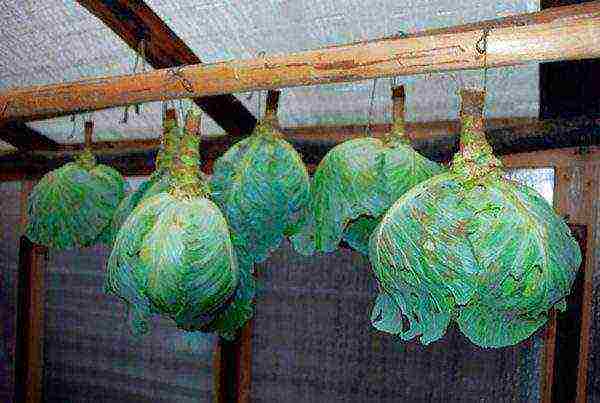
Some keep cabbage hanging not in nets, but by stumps
- You can make a pyramid from heads of cabbage and sand. The largest specimens should be placed at its base, which are placed with stumps up. A layer of cabbage must be completely covered with sand, and the next layer is to lay smaller heads of cabbage (they must be placed with stumps down), which are again covered with sand. According to this principle, heads of cabbage are placed to the very top of the pyramid. You can also cover the heads of cabbage with sand in the box.
- Heads of cabbage can be wrapped in cling film or a thick layer of paper.
Video: Savoy cabbage is a worthy competitor to white cabbage
Reviews
Savoy cabbage care is not difficult, and its nutritional value is very high. Try to grow this uncommon culture on your site and, perhaps, it will become your favorite.
This cabbage was grown several centuries ago in the Italian county of Savoie. It came to us at the end of the 18th century, but until now summer residents rarely grow it in their gardens, preferring the usual white cabbage. Nevertheless, according to scientists, savoy cabbage has a complex of vitamins that is twice as rich as white cabbage. It is distinguished by its great endurance, frost resistance. Some varieties of Savoy cabbage, under certain conditions, can continue their growing season in winter, and in May they are already harvesting.
Features of savoy cabbage
Outwardly, Savoy cabbage is very similar to white cabbage. Unless, due to the corrugated texture of the leaves, its head is looser to the touch and its color is more intense green.
Some gardeners take it for a white cabbage hybrid, but this is not the case. Savoy cabbage is a separate subspecies of white cabbage, which has its own specifics of cultivation, care, etc. But nevertheless, it differs little from the features of the construction of a vegetable that is more familiar to us.
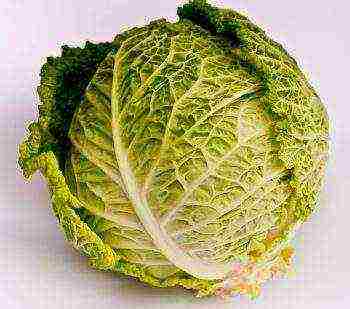
What does a savoy cabbage fruit look like close-up
This culture stands out for its cold and drought resistance, it is less affected by diseases and pests than others. She can tolerate heavy soils, peat bogs normally. She likes floodplain areas. In the land, which is determined for planting savoy cabbage, it is recommended to apply fertilizers, especially organic (8-10 kg / sq. M) and increased doses of phosphorus - on heavy loams, potash - on floodplains.
Savoy cabbage properties:
- Due to the fact that savoy cabbage is easily absorbed by the body, it is recommended for dietary nutrition, diabetes, as well as for children and elderly people.
- It is used in the preparation of the same dishes as white cabbage. You can't just ferment it.
- This vegetable is rich in proteins, carbohydrates, organic acids, fiber, vitamins C, B1, B2, K, E, provitamin A, and mineral salts. Especially potassium.
- Savoy cabbage, in comparison with other types of this vegetable, contains the most sinigrin - a substance that has anti-cancer and antibacterial properties.
- It tastes more tender and pleasant than white cabbage.
- Low yield. Stored for no more than 2 months.
- Savoy cabbage can be left in the garden in the winter under the snow. And in January-February, clean up the snow, cut down the cabbages, put them in cold water for a few minutes and use them.
- It is the most frost-resistant of all other types of cabbage (it can withstand temperatures down to -8 ° C).
Savoy cabbage cultivation
The technology for growing seedlings of this culture is in many ways similar to growing white cabbage. Early ripening varieties are sown in mid-March, mid-ripening and late-in mid-April. Seedlings are planted with a row spacing of 40-50 centimeters. At the same time, in a row, the distance between plants for early-ripening varieties is 30 centimeters, for late-ripening ones - 40 centimeters.
After the seedlings have hatched, the temperature is reduced to 8-10 ° C. When cotyledons or one or two leaves appear, the beds are watered to facilitate the selection of seedlings.
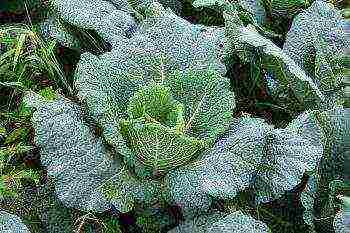
Savoy cabbage is one of the most popular vegetables
It is better to water the seedlings in sunny weather in the morning, and then air them. It is advisable to dive seedlings into nutritious pots or cubes. During the day, in sunny weather, the seedlings should be shaded for 2-3 days with a newspaper dipped in water. Savoy cabbage seedlings will be ready for planting when 4-5 true leaves appear in about 40-45 days.
To plant early varieties of Savoy cabbage, which are more early ripening, you should choose sunny, sheltered from the wind areas. It's good if legumes, potatoes, tomatoes, cucumbers, beets, onions grew on them before.
Savoy cabbage needs many nutrients in an easily accessible form. Therefore, the soil for planting must be prepared in the fall. First of all, it must be loosened to a depth of 8-10 centimeters, and when the weeds sprout - after about two weeks - add 5-7 kilograms per square meter to it. m of organic fertilizers and dig up on a full bayonet of a shovel.
In early spring, the area should be disassembled so that moisture remains in the soil. On the eve of planting seedlings, the site must be dug to a depth of 12-14 centimeters.
When planted very early in open ground, early varieties of Savoy cabbage are covered with a transparent film, since under prolonged exposure to low temperatures, plants can begin to shoot. These varieties can be planted until the end of May at several times. Mid-season and late varieties should be planted in late June - early July.
When planting, the distance between plants in early varieties is 35-40 centimeters, between rows - 40-15 centimeters. Planting scheme for mid-ripening varieties - 50x50, late-ripening - 60x60 centimeters. After 5-6 days, replanting new ones should be carried out in place of the dead plants.
Savoy cabbage care
This culture requires careful maintenance. It needs to be regularly loosened, fed and hilled.
The first loosening and weeding, especially on heavy soils, is very important to carry out on time - immediately after planting to a depth of 5-7 centimeters, while simultaneously removing weeds. The depth of subsequent loosening should be increased to 12-15 centimeters. If the cabbage is planted on dry and light soils, loosen it more finely, on heavy and wet soils - deeper. Around the plants, it is necessary to loosen very finely so as not to damage the rhizomes.
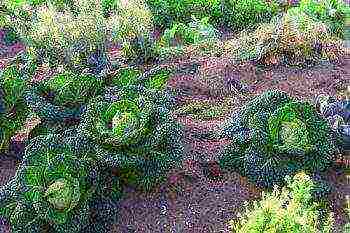
Correctly planted cabbage in the garden
When to feed Savoy cabbage
- The first feeding of plants is carried out when they grow. It consists of a mullein solution (1:10) or a mixture of mineral fertilizers (for 10 liters of water - 15 grams of urea, 40 grams of superphosphate, 15 grams of potassium fertilizers).
- The second is done during the period of curling the head of cabbage: increase the amount of potash and phosphorus fertilizers by 1.5 times.
It is necessary to spud all varieties of Savoy cabbage 3-4 weeks after planting. Before closing the rows, the late varieties must be hilled a second time.
Early varieties most often need to be watered in May; late - from mid-July to mid-August.
Savoy cabbage harvesting and storage
Early ripe varieties of Savoy cabbage must be harvested selectively, starting at the end of June. You shouldn't be late with harvesting, because the heads of cabbage can crack. To avoid this, you can trim the bottom leaves or carefully trim the roots.
You should not rush to collect late-ripening varieties, since they are not afraid of frosts.When cutting off heads of cabbage, leave 3-4 outer leaves on them, which will protect the inner leaves from breaking off. Mature heads of late varieties can be left in the garden for the winter under the snow. And cut them off as needed.
Savoy cabbage is nowhere near as well stored as white cabbage. Therefore, it only needs to be stored in one row in boxes or on shelves. To extend the shelf life, the storage temperature must be lowered to -1-3 ° C frost.
Savoy cabbage varieties
| Varieties | Ripening period | Description |
| Early ripe | Up to 120 days | 1. "Jubilee". Head of cabbage weight up to 0.8 kg, prone to cracking.
2. "Gold early". Heads of cabbage are round. Weight up to 1 kg. Resistant to cracking. High-yielding. 3. "Julius F1". Head of cabbage weight 1.5-3 kg. |
| Mid-season | 120-135 days | 1. "Melissa F1", a fruitful hybrid. Resistant to cracking Heads weight up to 3 kg.
2. "Sphere". Heads of cabbage do not crack. Weight up to 2.5 kg. |
| Late | More than 140 days | 1. "Ovassa F1" is a hybrid of Dutch selection. Harvested. Unpretentious. Head of cabbage weight up to 2 kg.
2. "I am turning 1340". Harvestable. Heads of cabbage weigh up to 3 kg. 3. "Verosa F1". Hybrid. Heads of cabbage weigh up to 3 kg. 4. "Morama F1" Hybrid. Heads of cabbage weigh up to 4 kg. |
Other popular Savoy cabbage varieties:
- 1. "Nyusha". An early ripe variety intended for personal subsidiary plots. It has a rounded head of cabbage, partially covered with leaves. Medium density. Heads of cabbage weigh up to 1.4 kilograms. The leaves are gray-green. Used in home cooking. It is not stored for long.
- "Thaler". Hybrid. Medium early. Has a flat, large head of cabbage. Weight up to 2 kilograms. Productivity 40-50 t / ha. It is not stored for long.
- "Tasmania". Medium early hybrid. It is not stored for long. Frost resistant. It grows well on soils with a low nitrogen content. A rounded head of cabbage weighs up to 1.5 kilograms.
- "Uralochka". Late variety. Salting and other types of culinary processing are possible. A round, dense head of cabbage weighs up to 2.2 kilograms.
- "Extrema F1". Mid-season hybrid. Resistant to fusarium wilt. The leaves are distinguished by their exceptional taste. It is not stored for long. Productivity 5.4-8 kg / sq. m.
Savoy cabbage diseases
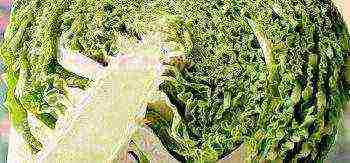
What does a savoy cabbage fruit look like in a cut
Alternaria - fungal disease. Signs: small brown necrotic spots appear on cabbage leaves.
Bel. Signs: cabbage with this disease looks like it is painted with white oil paint. Eventually, the plant turns brown and dries up.
Keela. Spherical and fusiform growths appear on the roots of cabbage. The roots turn brown and rot over time.
Downy mildew... Yellowish spots appear on cabbage leaves. Their inner side is covered with a white bloom. The lower leaves turn reddish yellow.
Mosaic. The veins of young leaves are bent, they are strongly contracted, and deformed. Later, a dark green border appears on the leaves. Light necrotic spots appear on the tissue between the veins.
Other diseases that can affect savoy cabbage: phomosis, vascular bacteriosis, fusarium wilt or tracheomycosis, black leg, black ring spot.
Disease control methods
In order to avoid diseases of Savoy cabbage, it is imperative to process the seed; strictly observe the rules of agricultural technology; fight weeds; after harvesting to destroy plant residues; systematically dig up the beds; Change the Savoy cabbage planting site every year.
If, nevertheless, the disease has struck your plants, you need to know: it is impossible to cure black spot and mosaic. Therefore, the sooner, the better, the heads of cabbage affected by the disease should be removed and burned, and the soil in which they grew should be watered with a strong solution of potassium permanganate.
Treat savoy cabbage with fungicides for fungal diseases. These are Fundazol, Fitosporin, Bordeaux mixture, copper sulfate, colloidal sulfur, etc.
Savoy cabbage is used in many different culinary dishes
Savoy cabbage pest control
Cruciferous flea. Gnaws small holes in cabbage leaves. At an early stage, you can fight the flea: cover the plants with non-woven material. Cabbage and the soil around the beds should be powdered with wood ash and tobacco dust in a 2: 1 ratio, after sprinkling them with water. Plant celery between the rows of cabbage, which the flea bean hates. In emergency cases, the beds should be treated with Actellik.
Spring cabbage fly. This insect lays eggs in the soil around the stems. And its larvae then eat up the roots and stems of the cabbage. Treat cabbage beds with preparations "Ambush", "Corsair", "Rovikurt".
Whitefish and scoops... The most dangerous are caterpillars that damage cabbage leaves. To avoid their invasion, it is advisable to plant the cabbage before the butterflies begin to fly out. Treat the beds with Ambush, Belofos, Rovikurt, Anometrin, Cyanox, Gomelin, Bitoxibacillin, etc.
Rapeseed and cabbage bugs... When the Savoy cabbage is damaged by bedbugs, its leaves turn yellow. Treat the beds with Actellika solution.
Aphid. It feeds on the juice of cabbage leaves, which lose color and curl. This small sucking insect spreads incurable viral diseases among plants. As a preventive measure, plant celery, dill, carrots between the beds of Savoy cabbage, to which hoverflies and ladybugs will reach, which exterminate aphids. Water and weed your beds regularly. Treat the beds with preparations "Ambush", "Rovikurt", "Biotlin", "Corsair".
In addition to all the listed pests, savoy cabbage can be affected by the cabbage root lurker, wireworm, bear, slugs.
In the fight against these pests, first of all, it is necessary to take preventive measures. And this: observance of crop rotation and agricultural technology; planting Savoy cabbage in open ground as early as possible; regular weed control; in autumn, cleaning and burning of all plant residues and deep digging of the site.
Question answer
- What are the benefits and harms of savoy cabbage?
Savoy cabbage has a very rich composition of nutrients. For example, it contains alcohol beckons, which is used as a sugar substitute. Therefore, this vegetable is recommended for diabetics. Savoy cabbage is also used as a prophylactic agent against cancer, because it contains chlorophyll, which prevents DNA molecules from changing in cells. Therefore, the risk of cell transition to malignant is reduced.
Savoy cabbage can be harmful to people who have recently had chest or abdominal surgery. It is contraindicated for people suffering from acute gastritis and enterocolitis, with exacerbation of ulcers, with increased acidity.
- I kept the cabbage wrapped in newspaper on the balcony. When unfolded, it turned out that it had become slimy and smelly. Can you still save her?
Such cabbage can no longer be eaten. She developed a slimy bacteriosis. This disease is transmitted through plant debris and seeds. In order not to carry the infection with seeds, they must be kept in water heated to + 53 ° C for 15-20 minutes before sowing. Then sow immediately.
Rate the quality of the article. We want to be better for you:
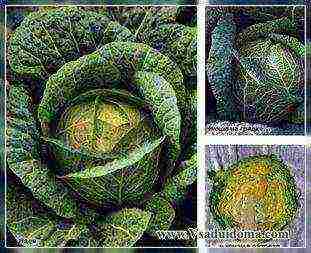 Sinigrin is a substance with antibacterial and anticancer properties. Studies by nutritionists have shown that Savoy cabbage contains the most of all types of cabbage. And if you take into account that Savoy cabbage is more tender and costs several times more expensive in the store than white cabbage, it is profitable to grow it in your country and backyard gardens. Savoy cabbage, which received its sonorous name in honor of the Italian region of Savoy, differs from white cabbage in a loose head of cabbage and corrugated leaves of a rich green (outer) or yellow (inner) color.In terms of yield, it is inferior to its white-headed relative, but it tolerates drought more easily and is the most cold-resistant and frost-resistant of all cabbages (late varieties can withstand frosts down to minus 8 °). In addition, although both "ladies" love floodplains, the "Italian" is better able to tolerate heavy soils, peat bogs and yield crops even in low areas. True, in this case, you need to take care of the sufficient application of organic fertilizers or the incorporation of green manure, increased doses of potash fertilizers on floodplain soils and phosphorus ones on heavy loams. On the latter, after harvesting the previous crop, the soil is loosened with a cultivator. When the weeds grow, they add superphosphate and potassium salt (30 g / m2 each) and dig up the garden bed. In the spring, to retain moisture, the soil is loosened with a rake and covered with non-woven material. In the lowland, the ridges are cut for cabbage.
Sinigrin is a substance with antibacterial and anticancer properties. Studies by nutritionists have shown that Savoy cabbage contains the most of all types of cabbage. And if you take into account that Savoy cabbage is more tender and costs several times more expensive in the store than white cabbage, it is profitable to grow it in your country and backyard gardens. Savoy cabbage, which received its sonorous name in honor of the Italian region of Savoy, differs from white cabbage in a loose head of cabbage and corrugated leaves of a rich green (outer) or yellow (inner) color.In terms of yield, it is inferior to its white-headed relative, but it tolerates drought more easily and is the most cold-resistant and frost-resistant of all cabbages (late varieties can withstand frosts down to minus 8 °). In addition, although both "ladies" love floodplains, the "Italian" is better able to tolerate heavy soils, peat bogs and yield crops even in low areas. True, in this case, you need to take care of the sufficient application of organic fertilizers or the incorporation of green manure, increased doses of potash fertilizers on floodplain soils and phosphorus ones on heavy loams. On the latter, after harvesting the previous crop, the soil is loosened with a cultivator. When the weeds grow, they add superphosphate and potassium salt (30 g / m2 each) and dig up the garden bed. In the spring, to retain moisture, the soil is loosened with a rake and covered with non-woven material. In the lowland, the ridges are cut for cabbage.
Reference by topic: Varieties of red cabbage, savoy, Brussels sprouts, kohlrabi and Chinese cabbage - cultivation and care
Savoy cabbage - planting and care
To get fresh forks from mid-July to the end of October, varieties of different ripeness groups are grown and seedlings are prepared at several times. It is prepared in separate cups or cassettes from mid-March (early varieties for fresh consumption) to the second decade of April (for processing and storage) in manure greenhouses or spring greenhouses. They are planted on the bed from mid-May to mid-June according to the 40 × 40 cm scheme. A week before planting on the bed, cabbage is stopped from watering. But on the day of planting, the plants (good seedlings should have 4-5 true leaves) are watered abundantly, planted with a clod of earth and shaded from the sun. Early varieties are placed according to the scheme 50 × 40 cm, middle and late ones - 60 × 60 cm or 70 × 50 cm. It is best to grow Savoy cabbage after legumes, potatoes, cucumbers, and onions. Beets and tomatoes are less desirable as they carry a lot of potassium and phosphorus out of the soil. You cannot plant this cabbage where there is a keel, and within 4 years after cabbage, radish, turnip, radish, rutabaga, daikon, mustard. Seedlings are protected from strong return frost, cruciferous fleas and cabbage flies with a non-woven cloth. It is completely removed in mid-June. The soil in the aisles during the season is loosened 6-8 times to a depth of 5-7 cm. Plants, however, three weeks after planting and before closing the rows high (to the lower leaves) are spud and mulched with hay or cut grass. Water the cabbage abundantly, but not more often than once a week. Top dressing with a complex soluble fertilizer with trace elements is given a week and a half after planting. If there is no ready-made fertilizer at hand, use an infusion of nettle, dandelion, dream, superphosphate (20 g) and ash (1 glass per 10 l of liquid). The same feeding is carried out in two weeks. For the next two dressings, only phosphorus-potassium fertilizer is used. From mid-July, poisoned baits with metaldehyde are laid out between the plants from slugs or a mixture of cement and hot pepper is periodically sprinkled. Heads of cabbage of early varieties should not be overexposed - they crack. They are cut when the forks gain weight of 400-600 g and acquire the color characteristic of the variety. You should not rush to harvest late cabbage, as lower autumn temperatures will only improve its taste. If the forks are cut, then two or three top green leaves are necessarily left on them and stored on racks in one layer at a temperature of 1-3 °. But in this case, the harvest does not lie longer than 3 months. Therefore, for winter storage, it is more advisable to remove the plant in October with roots, having previously protected the head of cabbage from soil contamination with gauze, and dig it in the basement. It is important that the mass of the head of cabbage is not less than 0.5 kg. And still late-ripening Savoy cabbage can be left to winter in the garden: in January-February, it is enough to shovel the snow, cut the head of cabbage and, without defrosting, immerse it in cold water with ice cubes for half an hour.Savoy cabbage is richer than its white-headed relative in mineral salts, and its caloric content does not exceed 30 kcal per 100 g. Therefore, this vegetable is necessary for people with metabolic disorders, diseases of the cardiovascular system and digestion. Savoy cabbage is used in the same way as white cabbage - fresh, boiled and fried. It makes excellent cabbage soup, borscht, mashed soups, stuffed dishes, including cabbage rolls and casseroles.
Reference by topic: Growing kohlrabi cabbage - care and varieties
The best varieties of savoy cabbage - description
Vienna early 1346 - early (60-75 days *) cultivar for culinary and fresh consumption. Forms a compact plant with a small head of medium density, weighing up to 0.7 kg. Gold early - early variety for fresh use. The head of cabbage is round, half-open, dense, weighing up to 0.9 kg, resistant to cracking. The leaf is medium-sized, yellow-green, highly bubbly, delicate in taste. Melissa - mid-season hybrid for autumn harvesting. Heads of cabbage are round-flat, large, weighing up to 3 kg, dense, resistant to fusarium and cracking. The leaf is highly bubbly, medium-flared, dark green, tasty. Nyusha - an early ripe variety for growing in private household plots. Used fresh and home cooking. Head of cabbage is rounded, partially covered, yellowish in cross section, of medium density, with a fine structure, weighing up to 1.4 kg. The leaf is gray-green, with a slight waxy bloom, of medium size, strongly bubbling, wavy at the edge, excellent taste. The outer stump is short, the inner stump is of medium length. Productivity 3.3 kg / sq.m. Ovass - late (120 days) hybrid for fresh consumption and cooking. Resistant to adverse conditions, slightly affected by bacteriosis, fusarium. Productivity 30-60 t / ha. Thaler - mid-early hybrid for fresh consumption, cooking and short-term storage. The head of cabbage is flat, large, weighing up to 2 kg. Productivity 40-50 t / ha. Tasmania - mid-early hybrid for fresh consumption, cooking and short-term storage. It tolerates the effects of severe frosts, grows well on light soils with a low nitrogen content. Head of cabbage is round, weighing up to 1.5 kg. Uralochka - late ripening variety (95-100 days) for all types of culinary use and salting. The head of cabbage is round, dense, yellowish on the cut, weighing up to 2.2 kg, resistant to cracking, stored for up to 3 months. The leaves are large, light green, strongly bubbly, corrugated, delicate in taste. Jubilee 2170 - early ripening (75-85 days) and the oldest Russian variety (used since 1950). A head of cabbage weighing up to 0.8 kg, medium density, prone to cracking. The leaf is slightly corrugated, finely bubbly, grayish-green. Julius is a very early Savoy cabbage hybrid for fresh consumption and cooking. A head of cabbage weighing up to 3 kg, with highly bubbly tender leaves. Extrem F1 - mid-season hybrid resistant to fusarium wilt for growing in the private sector. Used fresh and for short-term storage. The outer stump is of medium length, the inner one is short. Productivity 5.4-8 kg / sq.m. A leaf of good taste and consistency, large, gray-green, with a waxy coating, bubbly, strongly frizzy, slightly wavy at the edge. The head of cabbage is round, yellowish on the cut, loose, weighing up to 2 kg. * - from planting seedlings to harvesting
Reference by topic: Growing broccoli cabbage with seedlings and seedlings
Savoy cabbage rolls - recipe
Disassemble the head of cabbage into leaves, soak them in boiling salted water for 10 minutes, cool in cold water with ice cubes. Put the meat or vegetable filling in the middle, roll the rolls, tie them with white threads and fry in vegetable oil. Then put in a saucepan, fill with broth or vegetable broth, seasoning with spices to taste, and simmer for 25-30 minutes.
Below are other entries on the topic "Cottage and garden - do it yourself"
Savoy cabbage (photo) planting cultivation and care: Growing and caring for the Savoy ... White cabbage - early, middle and late varieties (description): The best varieties of white cabbage: late, ... Several varieties of sweet peppers for successful cultivation: One cannot help but praise ... Cabbage variety buffalo heart: Cabbage "Buffalo Heart" This is quite rare ... Red cabbage variety Kalibos: Kalibos and others Red cabbage to ... Growing white cabbage - planting and care (Tver region): Planting and caring for cabbage ... The secret of planting cabbage ( Karelia): I would like to share some advice on landing ...
Subscribe to updates in our groups.
Let's be friends!
